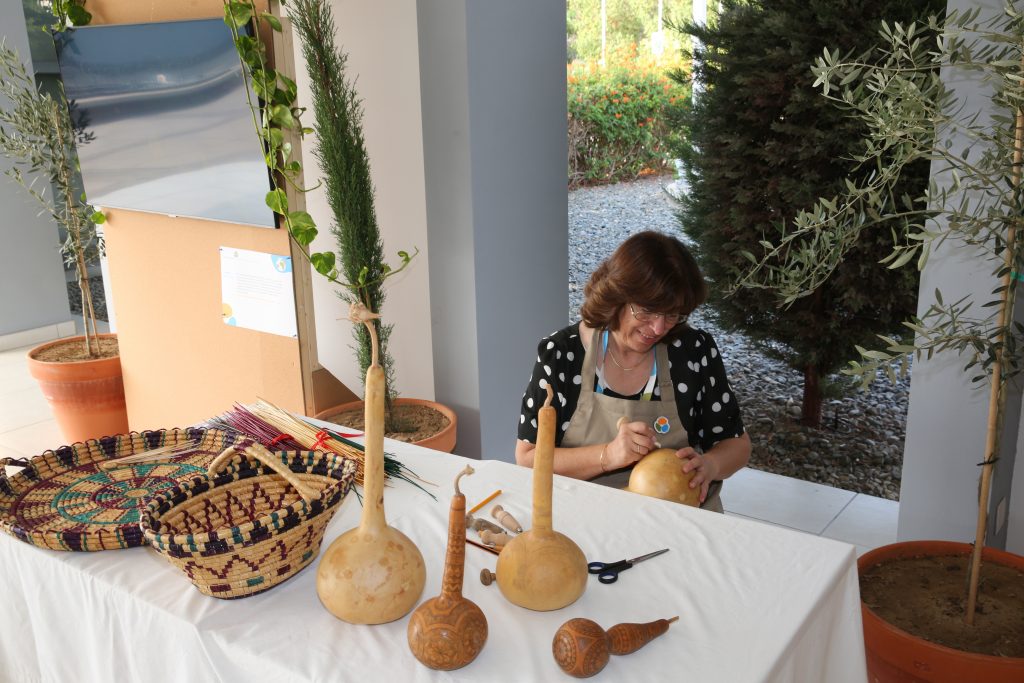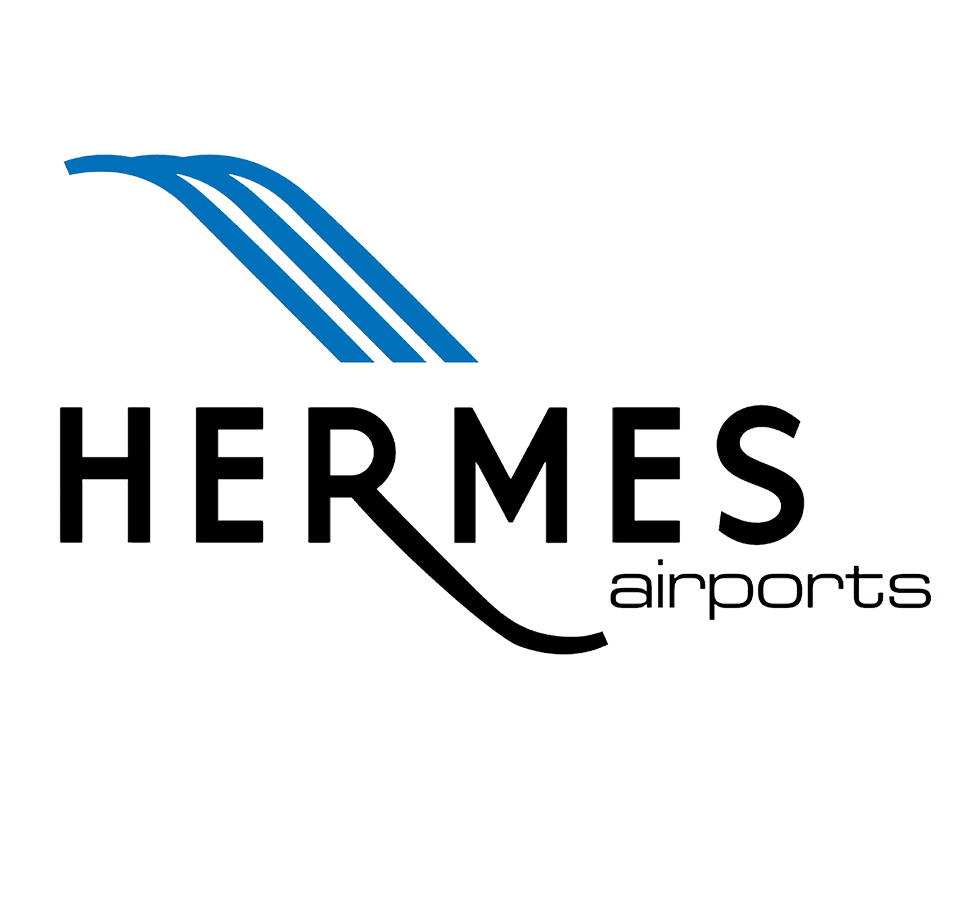Cypriot craftspeople at work, ‘Filoxenia’ Conference Center, Nicosia

Traditional handicrafts and products of Cyprus
1.Traditional weaving (Αργαλειός /Βούφα – Argalios/Voufa)
An introduction to the traditional loom and the Cypriot weaving technique used to weave cloth and tapestry.
Greek myth
Arachne in Greek mythology, was a Lydian woman, thought by some to be a princess, who was highly gifted in the art of weaving. Arachne was no ordinary weaver and the very act of her weaving was sheer magic and a sight to behold.
News of Arachne’s artistry spread far and wide and it is said that nymphs from the forests left their frolicking and gathered around Arachne to watch her weave. So moved were they by her skills that they remarked that she surely must have been trained by none other than Goddess Athena, the goddess of weaving.
All this adulation was more than Arachne could handle and being an ordinary mortal who was quite vulnerable to human failings, she became quite arrogant about her superior skills. She was annoyed at being regarded as a pupil of Athena and began bragging about her skills, proclaiming herself to be far more superior to Athena.
When the goddess of weaving heard of Arachne’s bold claims, she was upset, but nonetheless decided to give the young woman a chance to regret her folly. Disguised as an old woman, Athena appeared before Arachne and warned her of the consequences of provoking the wrath of the gods, but Arachne was not a bit remorseful and challenged Athena to a contest, declaring that if she lost, she would accept any punishment that Athena would decide for her. Athena revealed her true form and accepted the challenge. The stage was set for a battle in which a god and a mortal pitted their artistic skills to decide who the better artist was. The nymphs who had come to watch Arachne weave shrank back, horrified at Arachne’s audacity, but Arachne was unshakable and stood her ground. And so the contest began, Athena at her loom and Arachne at hers, each working with threads of gold and a splendid array of colors to decide who would outdo the other in this ultimate trial.
What unfolded next was a feast for the eye. Athena created a tapestry replete with scenes from the history of the gods. She portrayed Zeus at the center of the Olympic pantheon as well as her own contest with Poseidon and her victory, which ultimately made the people of Athens name their city after her. At the corner of her tapestry, she artfully depicted humans who had dared to defy the gods and who had been punished without a trace of mercy.
As for Arachne, she deliberately chose scenes that depicted the infidelities and amours of the gods. She vividly portrayed Zeus and his string of indiscretions. She showed how Zeus had turned into a swan to rape the Spartan queen Leda; a bull to entice Europa; an eagle to abduct Aegina; as a shower of gold to seduce Danae; and as a satyr to seduce Antiope. Arachne’s work of art, according to the Latin narrative, featured twenty-one scenes of the various misdemeanors of the mighty gods, including Poseidon, Apollo, Dionysus and others.
Although Arachne had shown little respect for the gods by choosing a subject that made a mockery of the supreme deities of the Olympus, even Athena had to admit that her work was brilliant and flawless. That, however, was not enough to calm down Athena who was incensed by Arachne’s humiliating portrayal of the gods. Athena destroyed in anger Arachne’s tapestry and loom.
Arachne, like many other foolish mortals, had dared to question the supremacy of the gods. She had, in her arrogance over her art, been blind to the consequences of challenging the gods. Still in anger, Athena transformed Arachne into a spider (“arachni” in Greek), proclaiming that Arachne and all her descendants would henceforth hang forever from threads and be skillful weavers.
https://www.greeka.com/greece-myths/arachne/
2.Lefkara Lace (“Lefkaritika”)
Lefkara lace, perhaps the best known Cypriot traditional embroidery, enjoys a worldwide reputation. Lefkara lace derives its name from the village of Lefkara, where the most difficult and complex designs are made. Lefkara lace is also made in the villages of Kato Drys, Ora, Skarinou, Athienou and Kornos. Lefkaritika, as the lacework is known, originated from the local white embroidery called asproploumia, which women throughout Cyprus made as part of their dowry. The all-white embroidery consisted of geometric patterns in satin stitch, combined with simple drawn-thread-work. Then, in medieval times the village of Lefkara became the favourite summer resort of the ruling Venetian families. Venetian ladies took their own embroidery there to while away the long, hot summer hours, and their designs influenced those of the local women, whose descendants produce today’s lefkaritika.
Originally, the lace was embroidered on handmade cotton material, using cotton thread. This was later replaced by linen. Local silk production also permitted the introduction of silk lace material into the design.
Nowadays, Lefakara lace is made on linen material imported from various countries with mercerised cotton threads in white, natural colour of beige. The range of stitches and patterns of Lefkara embroidery is wide. Some derive from Venetian times, other motifs are pre-Venetian, still others are said to have been taken from the cave drawings of Ayios Neophytos, the twelfth-century Cypriot hermit.
Lefkara lace is used mainly for tablecloths, napkins, tray-cloths and curtains. In the past it decorated the various parts of the four-poster bed, i.e., hangings, sheets, pillowcases, bedcovers and side and top curtains.
All these formed part of a girl’s dowry, which was necessary for her future life. It was a form of artistic expression for young women that proved their skill and talent. In addition, it was a challenge which often resulted in the creation of masterpieces of art and craftsmanship.
3.Beekeeping
The earliest human records indicate that people were collecting honey and using it as a sweetening agent centuries ago. Even prior to human involvement, fossil findings indicate that honeybees were busy in their hives making honey for their own use. Egyptians, Greeks, and Romans used honey medicinally and as food, and they offered it to their gods. Eventually, sugar was developed, and it began to replace honey as a popular sweetener.
Cypriot honey derives from flowers such as : eucalyptus, orange, cherry, plum and apricot, thyme, wild lavender, myrtle and sumac.Honey contains a variety of vitamins and minerals, including vitamin B, potassium, and phosphorus. Honey also has medicinal properties that make it beneficial as a home remedy for some health issues.
Greek Myth
Greek mythology has several gods who are associated with bees. Aristaeus is the god of beekeeping. After inadvertently causing the death of Eurydice, who stepped upon a snake while fleeing him, her nymph sisters punished him by killing every one of his bees. Witnessing the empty hives where his bees had dwelt, Aristaeus wept and consulted Proteus who advised him to give honour in memory of Eurydice by sacrificing four bulls and four cows. Upon doing so, he let them rot and from their corpses rose bees to fill his empty hives.
Prophecy in Ancient Greece seems to have been associated with bees. The Homeric Hymn to Hermes acknowledges that Apollo’s gift of prophecy first came to him from three bee-maidens, usually but doubtfully identified with the Thriae, a trinity of pre-Hellenic Aegean bee goddesses. In addition, the Oracle of Delphi is referred to as “the Delphian bee” by Pindar.
In Mycenaean Greek and Minoan myth, the bee was an emblem of Potnia, also referred to as the “Pure Mother Bee”. Her priestesses received the name of Melissa, (“bee”). According to the Neoplatonic philosopher Porphyry, the priestesses of Demeter were also called “Melissae”, and Melissa was a name of Artemis. Melisseus was the god of honey and bees, whose daughters Ida and Adrasteia fed the infant Zeus with milk and honey when his mother hid him from Cronus.
https://en.wikipedia.org/wiki/Bees_in_mythology
4.Pumpkin (Gourd) Carving!
The engraving of the gourd is a folk craft developed in Cyprus over many years. Dried gourds have traditionally been used for a variety of household uses with the most widespread application being for water bottles and wine pitchers. The decoration on the gourd is made with a sharp knife or a fiery hot poker (pyrograph) and the decorative motifs can vary from geometric to floral motifs to animal images. https://events.euintheus.org/events/cyprus-pumpkin-carving/
5.Wine
Cyprus has been a vine-growing and wine-producing country for millennia and wine. There is archeological evidence that winemaking on the Mediterranean island may have existed as many as 6000 years ago. Internationally, it is best known for the Commandaria wine. Most wine production remains based on a few varieties of local grapes such as Mavro and Xynisteri although international varieties are also cultivated.
https://en.wikipedia.org/wiki/Cypriot_wine
Zivania or zivana is a Cypriot pomace brandy produced from the distillation of a mixture of grape pomace and local dry wines made from Xynisteri and Mavro grapes. The name of zivania is derived from zivana (Greek: ζίβανα) which means pomace in the Greek dialect of Cyprus. Zivania is colourless and alcoholic with a light aroma of raisins. Its alcohol content varies, with 45% by volume being the typical value. As defined by law, zivania shall not have more than 60% alcohol content. Zivania contains no sugars and has no acidity.
https://en.wikipedia.org/wiki/Zivania
Wine derivatives
Palouzes:
Palouzes or moustalevria – from moustos (must) and alevri (flour) – is a thick, jelly-like sweet made from grape must. The traditional way of extracting must was through pressing grapes with the feet, a method which is now used only in some villages around the island.
The traditional way of making palouzes is by mixing 10kg of grape must with 1kg of flour and heating the mixture while stirring continuously until it coagulates, adding rose water, cinnamon and mastic towards the end so as to maintain their aroma. Palouzes is then poured into plates where it is left to cool. Some people enjoy eating palouzes hot but it is more commonly served cold with a garnish of almonds or walnuts, whole or crushed. Due to its high moisture content, it has a few days of shelf life if not refrigerated. Palouzes that is left to dry in the shade is cut into rectangular shaped pieces to give another traditional sweet food, kiofterka, which has a longer shelf life. This is a favourite energy food, often consumed along with zivania, a perfect warm-up during the winter.
Shoushoukkos:
This is the best known of all grape juice products in Cyprus. It is possible that the name comes from the word sujuk (Turkish sucuk or Armenian soujouk, which is a type of sausage) because of its shape after it has been prepared. The product is made with almonds or walnuts, shelled and soaked to turn soft, and then sewn onto a cotton thread around two metres long. The thread is dipped several times in finished palouzes, a process that may take several days since each layer has to dry on the string before a new one is added. Every time it is dipped, a new layer of palouzes is added to the previous one until its diameter reaches four to six centimetres.
6.Basket weaving
The term “soft basket-weaving” defines the craft of making a specific group of baskets (baskets, “talaria” i.e. baskets used in the cheese-making process) bags of different types and sizes, street sweepers – “froukalia”, pack baskets called “syrizes”, smaller baskets for packed lunches called “korokolioi”, weave string-like trays hanging from the beams to store bread called “tapatzia”, straw-mats and flat straw baskets called “zembilia”. This craft is also associated with the use of the woven cord to make traditional chairs (so-called “tonenes” chairs) apart from baskets.
The Akrotiri salt-lake and grassland is one of the most important wetlands in the Eastern Mediterranean, renowned both for its flora and its fauna. In this grassland the inhabitants can find the raw materials they need for basketry, a craft which is directly associated with the identity of the Akrotiri community. Soft basket-weaving constituted the main occupation of Akrotiri inhabitants for years and with the products sold they managed to secure a living. Both men and women knew the craft of basketry and made useful objects, necessary for the everyday traditional rural life in Cyprus. These objects were transported on donkeys’ backs crossing the salt-lake through an area called Kourtellin all the way to Limassol to be sold at markets.
Specific types of grasses (11 plant species) were used, which were harvested usually during the summer months. The plants would be left in the sun to dry for 6-7 days and then stored in special areas and used throughout the winter months. In order to make the fibres soft enough to be able to be woven, they had to be soaked overnight in water. In some cases, such as for example in making the “talaria” baskets used in the cheese-making industry, fresh pinweed plant would also be used to make the bases.
The main basketry products are baskets (of different sizes depending on the needs and uses): “talaria” baskets (used to strain the cheese), woven basket-bags or “tsentes” (in different sizes for transporting agricultural produce), “froukalia” (small usually hand-held brooms), “syrizes” (two large back baskets connected in the middle and placed on the donkeys’ backs to transport products), “korokolios” (a container for storing and transporting foodstuffs or packed lunches), “tapatzia” (a flat tray-like basket hanging from the ceiling to store bread and other bakery products), a traditional straw-mat, the “zembili” (baskets used during sowing seeds or harvesting olives) and woven bottle-covers (used to protect the wine demijohn type of containers).
7. Cypriot Pottery
Ceramics is an ancient craft that has become one of the most impressive areas of Cypriot arts and crafts thanks to the ease of working with the materials and its widespread use in daily life. It was first documented in Cyprus in the 9th-8th centuries BC. (See «The Cyprus Museum» : The Cyprus Museum: a two-hour tour of millenia). Products made of clay by Cypriot artists found fame in Europe in the 14th century, namely «pitharia» (giant earthenware vessels, long been used to store and transport wine, vinegar, oil or water). Some forms of pottery (pots, vases and jugs) and their production methods are still used today and continue to enjoy great popularity.
Cyprus’s rich copper resources were highly valued throughout the ancient world but it also exported jugs and other ceramicware in exchange for luxury goods: jewellery made from precious metals, products made from ivory, chariots and horses, valuable furniture, etc.
The ceramics of prehistoric Cyprus is diverse in its form and decoration, particularly that from the early and mid-Bronze Age. For example, terracotta figurines, which were made in rather large quantities, were placed in the tombs of noble women throughout the bronze age. They often depicted female figures symbolising rebirth. The Late Bronze Age (1600-1050 BC) saw copper mined and exported on a large scale which increased Cyprus’ trade with Egypt, the Middle East and the Aegean region.
Kilns found in various areas indicate that pottery flourished there for centuries. Further proof is provided by the large numbers of vessels found dateing back to the Eneolithic period (3000-2500 BC), the Bronze Age (2300-1050 BC) and the Geometric period (1050-950 BC).
It is particularly interesting that there is a legend stating the art of making vessels from clay was invented in Lapithos by Kiniras, the ancient king of Paphos and founder of the cult of Aphrodite.
What about the local artists and craftspeople? Local craft workers were inspired by the world around them, the nature of Cyprus, and influenced by the prevailing worldview of their particular time and drew on all this to produce the variety of forms, motifs, patterns found in their work. They created their art and built up experience, which would go on to form the unique, recognisable character of the local art and crafts of the area, including pottery. All this is part of Cyprus’ rich cultural and artistic heritage.
http://cyprusfortravellers.net/en/review/ceramics-and-pottery
https://www.hellenic.org.au/cypriot-pottery
8.Macaroni
A local traditional pasta has been adopted by the EU Commission as a new protected geographical indication (PGI) from Cyprus.
‘Makaronia tis Smilas’ (literally ‘skewered pasta’) or ‘Macaroni tou Sklinitziou’ due to the hole that remains in the middle, after rolling the pasta dough around a thin skewer, is a type of handmade dried pasta, made by mixing water with a little salt and durum wheat flour or other types of flour with semolina, salt and water.
“The characteristics of the product are the result of the local know-how and the experience of their producers. In particular, the special tool used for the preparation of pasta is of great importance. The thin reed-shaped stem is carefully selected,” a press release by the EU Commission said.
According to the statement, another skill required for the production of this pasta is to place the pasta in drying baskets traditionally called ‘paneria’, in such a way that the pasta does not come into contact with each other.
This tasty makaroni is often consumed during festive or special events. This particular type of pasta was one of the dishes specially prepared at traditional Cypriot weddings that were a week-long affair in the past and would usually be eaten either on the Sunday of the wedding day itself or on the Tuesday after the wedding.
According to information available from local culinary history books, this specific type of pasta was typically produced at night during the summer months, by the women of the family together with their friends over a good chat.
The distinct thin, cigar-shaped pasta featuring a distinct hole through the middle, would usually be boiled in chicken broth and served with a generous helping of traditional Cypriot cheeses – halloumi or the ricotta-type anari.
In some villages on the island locals were a bit more adventurous, preparing the pasta in a tomato sauce with pigeons in the village of Peristerona, while in the village of Lysi, they would boil the tubular-shaped makaroni in honey or carob syrup.
The new name will be added to the list of 1,587 currently listed agricultural and food products.
The list of all protected geographical indications is available in the eAmbrosia database (https://ec.europa.eu/info/food-farming-fisheries/food-safety-and-quality/certification/quality-labels/geographical-indications-register/ ).
9.Sweets and Pies
Cyprus, as a crossroad of three continents, has been affected culturally and
linguistically by neighboring countries but also by the different civilisations
that passed from the island through the centuries. This cultural alloy also
includes sweet gastronomic indulgence, the traditional sweets of Cyprus,
otherwise known as “glitzista” that are rooted back to ancient times and Byzantium. Adding a modern touch to this delicious feast you get a result that
will amaze even the most refined palate.
‘Pittes tis Satzis’ are also called ‘Sakopites’ or ‘Kattimerka’. They were named after the utensil in which they are cooked (a satzi pan). Satzi or Satzin is a shallow curved metal pan (like a shallow wok). Its hollow part is heated by fire while the pies are baked on the convex part. People used a Satzi pan to make ‘Chilopites’ (traditional pasta) also known as ‘Tripites’, as well as ‘Laggopites’. Moreover,‘Burekia’ with halloumi cheese are also made on the satzi pan.The filling is usually either with sugar and cinnamon or with honey and cinnamon. There is also a savoury version with grated traditional halloumi, fresh mint, and olive oil.
10. Crochet (“Smili”)
Crochet is a process of creating textiles by using a crochet hook to interlock loops of yarn, thread, or strands of other materials. The name is derived from the French term crochet, meaning ‘small hook’. Hooks can be made from a variety of materials, such as metal, wood, bamboo, or plastic. The key difference between crochet and knitting, beyond the implements used for their production, is that each stitch in crochet is completed before the next one is begun, while knitting keeps many stitches open at a time.
11. Cathedra, (Latin: “chair,” or “seat”), Chair (“Chaera”)
Chaera is the word meaning chair in the Cypriot dialect. Roman chair of heavy structure derived from the klismos—a lighter, more delicate chair developed by the ancient Greeks.
The cathedra was used in the early Christian basilica as a raised bishop’s throne placed near the wall of the apse, behind the altar. Later, a bishop’s principal church, or seat, within his diocese was designated a cathedral. The term ex cathedra (“from the seat, or throne”) was used in Roman Catholicism to distinguish solemn pronouncements by the pope on matters of faith or morals. The word chaera passed into the French-occupied Cyprus during the Lusignan era.









